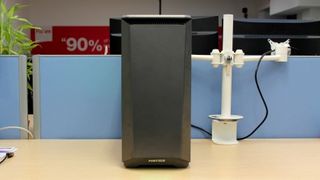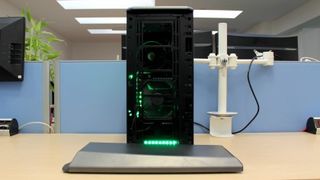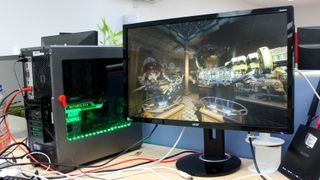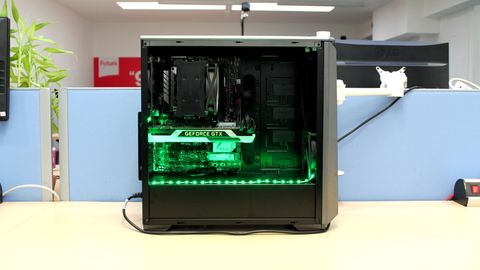TechRadar Verdict
It may not look its asking price, but the Titan Virtual Force VR delivers where it matters: performance. Nvidia's GTX 980Ti provides silky-smooth frame rates in games, all while costing less than its pre-built rivals.
Pros
- +
Great performance
- +
Good value
- +
Handily-located ports
Cons
- -
Uninspired case
Why you can trust TechRadar
Will the HTC Vive or Oculus Rift take the VR headset crown? The jury is still out on that one, but it's guaranteed that you'll need a meaty gaming rig to do either of them justice. And powerful hardware doesn't come cheap.
Of course, one option to save some cash is to build a VR-ready gaming PC yourself, which can be done for under £800 (around $1,160 or AUS$1,680) with some savvy component selections. Another is to bite the bullet and empty your wallet on a pre-built machine such as the Overclockers Titan Virtual Force VR Gaming PC.

At £1,329 (around $1,820 or AUS$2,535), this VR-ready vessel from the Stoke, UK-based PC builder isn't cheap in comparison; however, its components have been hand-picked to deliver the sort of VR experience that you've probably dreamt about in your sleep. And yes: that includes emptying a round of staples into a mug before lobbing it across a virtual office on Job Simulator.
The Virtual Force was used to power the public HTC Vive demo at Overclocker's HQ back in March, such is the company's confidence in its abilities.

Design
Overclockers has picked Phantek's value-conscious Eclipse P400 case for the build. Decked in an unassuming gun-metal grey color, its chamfered edges prevent it from looking too much like an office PC. While it has a certain minimalist charm, the P400 fails to rev my engine in the same way Lenovo's similarly-priced, steathily-styled Ideacentre Y900 does. Even the Virtual Force's green RGB LED strip that lights up the components inside feels a little tacked on to desperately add extra spice.

What the case lacks in style it makes up for in practicality. The pop-on front panel comes away easily to provide access to the 120mm fan and remove any dust, and its large-windowed side panel slides away without difficulty. It's not a tool-less design like the Ideacentre Y900 is, but I was able to remove the two screws holding it in place in seconds using the correct tool.
The top of the case features two USB 3.0 ports which I found useful for charging a smartphone and hooking up a wired Xbox 360 Windows controller. Positioned together, two more high-speed USB ports can be found round the back that can be used for connecting a VR headset.

Spec sheet
Here is the spec sheet of the Virtual Force Gaming PC supplied to techradar for review:
- CPU: 3.5GHz Intel Core i5-6600K (quad-core, 8MB cache, up to 4.5GHz with Turbo Boost)
- Graphics: NVIDIA GeForce GTX 980Ti (6GB GDDR5 RAM), Intel HD Graphics 530
- RAM: 8GB DDR4 (2,400MHz)
- Storage: 128GB SSD (PCIe 3.0 x 4 NVMe), 1TB HDD (7200RPM Sata 6GB/s)
- Optical Drive: None
- Ports: (Rear) 2 x USB 3.0, 2 x USB 2.0; (Top) 2 x USB 3.0, DisplayPort, DVI, VGA, HDMI, microphone and headphone jack
- Connectivity: Ethernet
- Size: 8.3 x 18.3 x 18.5 (W x H x D) 210 x 465 x 470 cm
The Virtual Force VR Gaming PC is offered with a number of customization options depending on your budget and required level of horsepower. The default Intel Core i5-6600K Skylake processor is more than sufficient for gaming but can be bumped up to Intel's flagship Core i7-6700K quad-core chip, which would provide a modest frame-rate boost, for £87 (around $126 or AUS$175).
Unless you frequently use video-editing and other multi-threaded applications that could take advantage of the Core i7's hyper-threading abilities (it can run eight virtual cores in total, versus the Core i5's four physical cores), it's best to stick with the default option. RAM can be doubled to 16GB for another £21 (around $30/AUS$42), which again wouldn't have much impact on gaming but is a tempting option if you're looking to future-proof your machine - especially for the price.

There are four choices of GPU, starting with Overclockers' own reference card version of Nvidia's GTX 980Ti included as standard. It can be swapped for an MSI-branded 980Ti for £46 ($66 or AUS$92) less, or EVGA's version for £26 (around $37 or $AUS52) less. Overclockers' version of the card is the highest-clocked on offer, featuring a base core clock speed of 1,102MHz, boosting to 7,010MHz under heavy load, so it's not worth swapping it out even for the cost saving. All three versions of the card come with the same healthy 6GB of GDDR5 virtual memory.
Benchmarks
Here's how the Overclockers Titan Virtual Force VR Gaming PC performed in our suite of benchmark tests:
- 3DMark: Cloud Gate: 23,647; Sky Diver: 29,055; Fire Strike: 14,865
- Cinebench: CPU: 732 points; Graphics: 155 fps
- Geekbench: 4,696 (single-core); 15,313 (multi-core)
- PCMark 8 (Home Test): 4,023 points
- Middle Earth: Shadow of Mordor: (1080p, Ultra): 113fps; (1080p, Low): 243 fps
- GTA V: (1080p, Ultra): 80 fps; (1080p, Low): 198 fps
The Virtual Force aced Valve's SteamVR Performance test, scoring an average quality of 11 (Very High) over just short of 13,000 frames. Whether scaring myself witless in the spooky Sisters demo, flipping the bird at online combatants in Hover Junkers or juggling office stationery in the air on Job Simulator, the system ran a series of VR games on the HTC Vive maxed out without any stutter.

Thanks to the GTX 980Ti inside, the Virtual Force even outpaced other gaming towers in its price bracket. Acer's Predator G6 looks a striking machine, but despite costing £250 (around $362 or AUS$502) more its comparatively weaker GTX 980 scored 11,584 in 3D Mark's demanding Fire Strike test versus the Virtual Force's 14,865.
But what does that mean when it comes to games? Rockstar's rig-punisher GTA V offers a clue. The Virtual Force managed a healthy 80 fps with the details cranked up to maximum at 1080p, compared to 52 fps scored by the Predator G6.
Lenovo's aforementioned Ideacentre Y900, which sells for £1,499 ($1,999, around AUS$2,768) with a GTX 980, managed 44 fps in the same test. Acer's and Lenovo's machines both come with larger capacity spinning hard disks than the Virtual Force, but if you're more concerned about frame rates then Overclockers' can provide them without the added cost.

Beyond 1080p, the Virtual Force is primed for higher resolutions and 4K gaming is on the menu. The GTX 980Ti's 6GB of video memory is more than sufficient to max out games such as Star Wars: Battlefront at 3,840 x 2,160, but be prepared to tweak a few graphics settings for more demanding titles like The Witcher 3 if you want to hit the golden 60 fps mark.
Final verdict
Like any pre-build gaming PC (and especially one designed for VR gaming), the Titan Virtual Force VR Gaming PC is not cheap compared to building a rig yourself. However, when you compare it against similarly-priced pre-builds from well-known manufacturers, Overclockers' system turns out to be the better performer while undercutting them on price. Nvidia's GTX 980Ti is a mighty powerful card and has the muscle to tear through the latest games, so you can be confident it will power the most demanding VR titles for at least the next year or two.
However, although it's a meaty machine, the Virtual Force's case prevents it from feeling like an object of luxury. Given the choice, it's unlikely that you would choose Phantek's P400 for a self-built PC costing well over a grand unless value was at the top of the agenda. As such, the Virtual Force is something you're more likely to tuck under your desk rather than place center-stage in the living room. The case's handily-located USB ports and easy-to-remove panels only just save it from being swapped for another.


